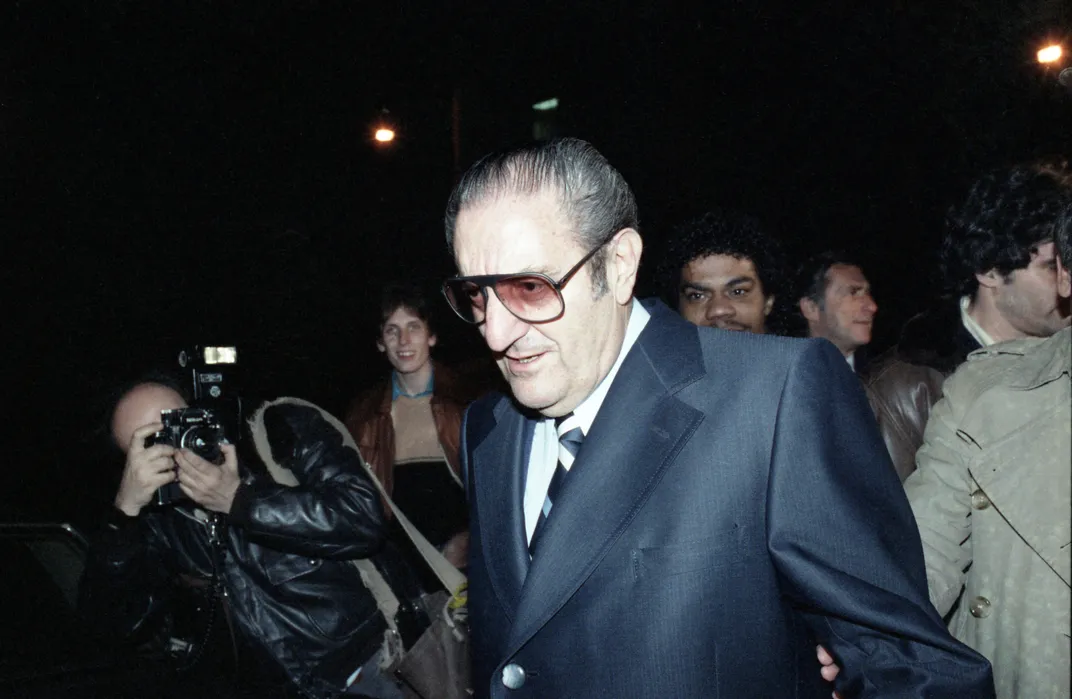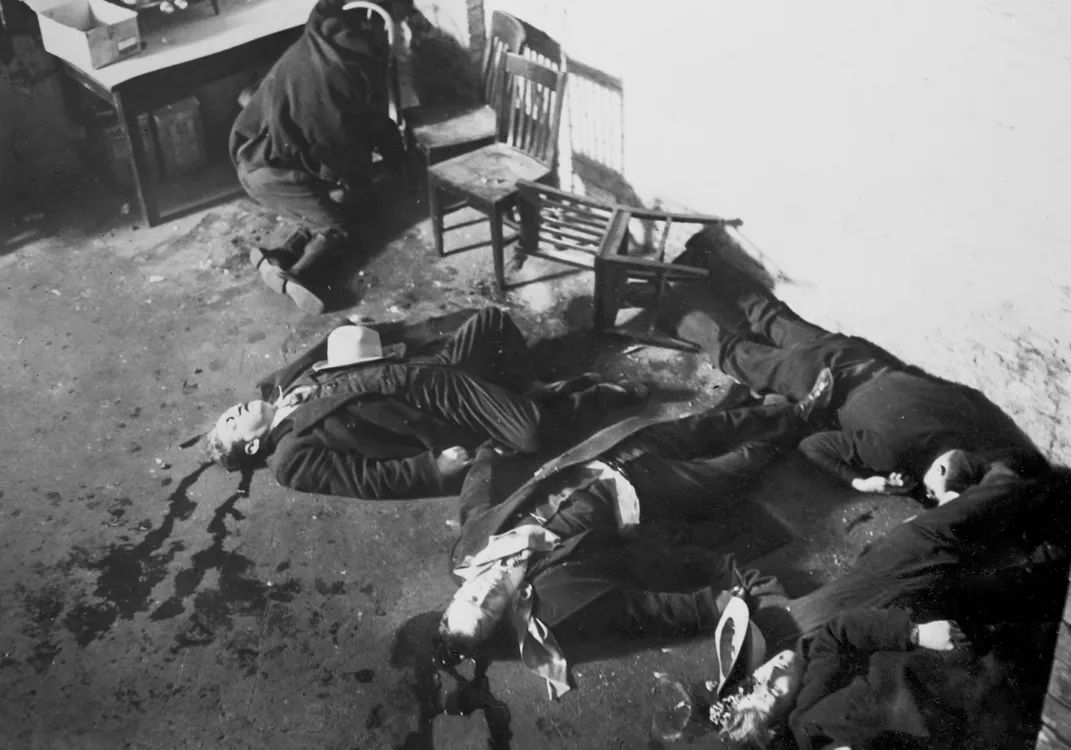Six of the Most Famous Mob Murders of All Time
The death of Gambino crime family head Frank Cali brings to mind these mafia killings from years past
:focal(804x1558:805x1559)/https://tf-cmsv2-smithsonianmag-media.s3.amazonaws.com/filer/2b/04/2b04d21b-d8c7-4309-8ffc-20b244c20293/new_lead.jpg)
Last week, Frank Cali, head of New York’s Gambino crime family, was murdered outside his Staten Island home, according to The New York Times, making this the first time a mafia family boss has been whacked since former Gambino don Paul Castellano was shot in 1985.
But in the first half of the 20th century, when the mob reigned supreme and was a staple of front-page news, high-profile killings were far more common and just as graphic, inspiring the gory imaginations of the American public. Here are some of the most notable mob murders of the last century. (Warning: Some of the photos are a little gruesome.)
Paul Castellano

Known as the “The Howard Hughes of the Mob,” Constantino Paul “Big Paulie” Castellano used his business savvy to bring the Gambino crime family to its financial apex by turning the family away from illegitimate business like drug trafficking towards the comparatively safer practices (for the mob at least) of money laundering and extortion. Though his focus was business, he didn’t shy away from calling hits, especially when it came to his daughter, Constance. He allegedly ordered the murder of her boyfriend, Vito Borelli, in 1975 after Borelli disrespected him, and allegedly had her ex-husband, Frank Amato, chopped up and thrown into the ocean when Castellano found out he had been abusing her.
But, like most people exposed to insane money and power, Castellano got greedy. He built a 17-room mansion on Staten Island designed to resemble the White House in 1981, and began to demand a larger cut from the mob’s earnings. Unhappy with the way Castellano was running the organization, Gambino capo John Gotti organized a crew that shot and murdered Castellano while he was walking into dinner at Manhattan’s Sparks Steak House in 1985. The killing sent the Gambino family into chaos and signaled the beginning of its decline.
St. Valentine’s Day Massacre

No list of mob murders would be complete without the infamous St. Valentine’s Day Massacre, the climax of Chicago gang warfare in the early ’20s. The combination of smuggling opportunities during Prohibition and lack of FBI firepower and infrastructure made the Illinois city a playground for mobsters like Al Capone. Looking to control the entirety of the Chicago underworld, Capone was ruthless in taking down his enemies and consolidating his organization.
In 1929, Capone’s sole remaining competition was George “Bugs” Moran, and on Valentine’s Day of that year, Capone sent two of his men dressed as police officers to raid the North Side garage that served as the headquarters for Moran’s bootlegging operations. Capone’s “cops” pretended to arrest the seven Moran mobsters they found there, ordering them to raise their hands and stand facing a wall, but when they had turned around, the “cops” revealed their identity via the rounds of Tommy Gun fire they unleashed on the men. Bugs himself narrowly evaded murder as he was running five minutes late to the garage, but he was rendered virtually powerless through the loss of so many cronies. The gruesome murder made Capone the undisputed king of Chicago, but it also led to his downfall. His official marking of “Public Enemy No. 1” led to increased efforts to take him down, and federal authorities would eventually nab him for tax evasion.
Angelo Bruno/Antonio Caponigro
/https://tf-cmsv2-smithsonianmag-media.s3.amazonaws.com/filer/e5/1b/e51bbbd1-1c26-4ed2-b386-fad8715afe85/angelo_bruno.jpg)
Angelo Bruno, head of the Philadelphia crime family, was known as the “Gentle Don” for his aversion to murder as a negotiating tactic, preferring to operate through bribery instead. He even banished one of his men, Nicodemo “Little Nicky” Scarfo, to Atlantic City for being too violent. Bruno’s consigliere, Antonio Caponigro, wasn’t a fan of the peaceful approach. Caponigro was upset that Bruno was limiting the gang’s involvement in drug trafficking, cutting Caponigro off from potential profits, and so he ordered a hit against Bruno in March 1980 via shotgun blast to the back of the head in Bruno’s car.
Since the hit hadn’t been authorized by the Commission — the Mafia’s governing body — Caponigro had to be punished for his disrespectful flouting of rank and procedure. Betrayed by his friend and co-conspirator, Frank Tieri, Caponigro was shot by Joe “Mad Dog” Sullivan while parked outside his Philadelphia home. His body was later found in the trunk of a car in the South Bronx with 14 bullet and knife wounds and roughly $300 stuffed into his mouth and anus to symbolize his greed.
Albert Anastasia
/https://tf-cmsv2-smithsonianmag-media.s3.amazonaws.com/filer/2d/5e/2d5eb4c8-2923-4a4b-82ad-72db3e4c8be5/albert_anastasia.jpg)
Known as “Mad Hatter” and “Lord High Executioner,” Anastasia was responsible for thousands of deaths during his reign of terror in the ‘30s and ‘40s and is considered one of the deadliest criminals of all time by the FBI. Anastasia made his big break in the mob as one of the bosses of Murder, Inc. — a group of contract killers that operated out of the back of a Brooklyn candy store. After the murder of the Gambino family boss (which was likely orchestrated by Anastasia), Anastasia became don of the crime family in 1951 in the midst of growing tensions between the Five Families, the major mob organizations of New York City.
It’s unclear who was responsible for Anastasia’s assassination, but it was likely a hit directed by another crime family. In October, 1957, Anastasia relaxed into his barber’s chair awaiting a shave and a haircut. Instead, he got shot by two men with scarves covering their faces. In an attempt to save himself, a shocked Anastasia lunged at his attackers, grasping wildly not at them, but rather their reflections in the mirror on the wall as they continued to pelt him with gunfire. The murder, and the vivid imagery of an unsuspecting Anastasia bleeding out while swathed in white towels, drew a massive amount of public interest.
Carmine Galante
/https://tf-cmsv2-smithsonianmag-media.s3.amazonaws.com/filer/78/01/78011084-b7c7-41ed-a55f-ffbc007af9ef/carmine_galante.jpg)
Though not a physically imposing mob boss—standing at just 5’5”—Galante was widely known and feared for cruelty. Ralph Salerno, a former New York Police Department detective, said Galante was one of the only mobsters to truly scare him, citing a dead-eyed, frigid stare of a killer. While imprisoned in 1931, Galante was officially diagnosed with a psychopathic personality.
A longtime member of the Bonnano family, Galante, known as “The Cigar” for his formidable smoking habit, seized power in 1974 after Bonnano head Philip “Rusty” Rastelli was sent to prison. As he had been underboss for the family for years, Galante considered himself the rightful heir, but his accession wasn’t approved by the Commission. Upset by Galante’s forceful attempt to control the narcotics market without sharing profits with the rest of the Five Families, Genovese family boss Frank Tieri petitioned the Commission to take down Galante on the grounds of his illegitimate succession as Bonnano boss. The Commission agreed, and Galante was gunned down in July 1979 while enjoying lunch at Joe and Mary’s Italian-American Restaurant in Brooklyn. A final picture of Galante shows a cigar dangling from his mouth when he died.
Bugsy Siegel
/https://tf-cmsv2-smithsonianmag-media.s3.amazonaws.com/filer/af/b8/afb8ca49-f97d-4700-af94-164b06349a6f/siegel_2.jpg)
Known as one of the most feared mobsters of the ’30s and ’40s, Siegel was also known as a prolific womanizer. He ran a major prostitution ring, romanced actresses and socialites, and even finagled a deal to have female visitors allowed while he was in jail. Though he got his start in New York organized crime, he was sent west to California and Las Vegas when it became too dangerous for him to stay on the East Coast.
In Vegas, Siegel reinvented himself in 1945 by going legitimate with the Flamingo Hotel. At the time, Vegas was still more desert than Sin City, and Siegel had a vision for the Flamingo as a draw for wealthy elites and tourists alike. He sunk $6 million ($84 million today when adjusted for inflation) into construction, continually assuring his mob bosses the investment would pay off. The December 1946 opening was a flop: guests were greeted by drop cloths and clanking from parts of the building still under construction, and the air conditioning kept failing. Though his second opening a few months later was much improved, the damage was done. It’s still unclear who took down “the father of modern Las Vegas,” but Siegel was shot twice in the head through the window while relaxing in his girlfriend’s home, with the pressure causing his left eye to blow out of its socket.
/https://tf-cmsv2-smithsonianmag-media.s3.amazonaws.com/accounts/headshot/jane.png)
/https://tf-cmsv2-smithsonianmag-media.s3.amazonaws.com/accounts/headshot/jane.png)